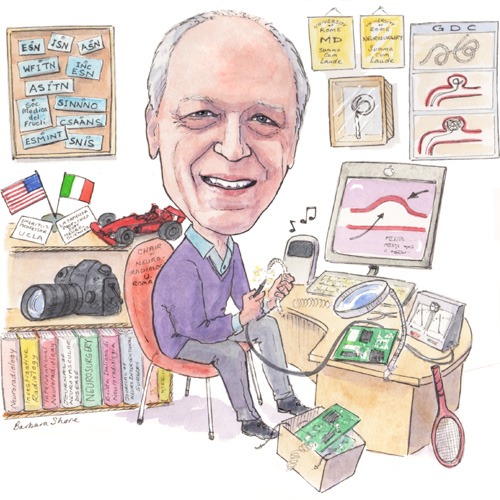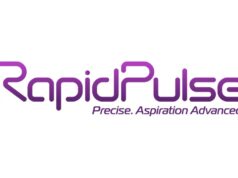
World-renowned as the inventor of the Guglielmi Detachable Coil (GDC), Guido Guglielmi speaks to NeuroNews about what inspired him to pursue that invention and gives his advice for aspiring inventors. Now retired, he talks about how he spends his time and addresses the three main questions in the field of endovascular neurosurgery that remain unanswered.
What drew you to medicine and to endovascular neurosurgery in particular?
My father was a physician and probably that is what drew me to medicine. At first I wanted to enrol in electronic engineering, but at the last minute I changed my mind and enrolled in medicine. During my course in medicine I was quite enthusiastic about the brain because it is constituted by millions of relays and millions of wires that transmit electricity and are connected to one another (I have been very interested in electronics since I was 10 years old). This is the reason why later on I wanted to become a neurosurgeon.
Who were your mentors and what wisdom did they impart to you?
During the preparation of my thesis and during my four years of fellowship in neurosurgery I learned the theory and the practical application of neurosurgery from professor Beniamino Guidetti who was the chairman of the Institute of Neurosurgery. He was very interested in vascular neurosurgery (mainly aneurysms and arteriovenous malformations). I learned from him the base of the discipline of neurosurgery. In particular, his motto was: “it is enough to look at an aneurysm to provoke its rupture”! I utilised this motto later on when I designed GDC coils soft enough not to rupture the aneurysmal wall.
What has been your most memorable case, and why?
Strangely enough, my most memorable case was not related to the GDC coils. In fact, I succeeded in reopening thrombosed brain vessels in a lady who had a stroke. I utilised t-PA to reopen the left internal carotid artery and the left middle cerebral artery. With this procedure I literally saved the life of the young lady. She was left with a minor neurological deficit only (minor signs of dysphasia), but she started again to work, to drive her car, and to lead a normal life. I consider this case memorable because it was performed at the beginning of the era of the endovascular treatment of stroke. So, it was a sort of pioneering work.
You are responsible for one of the most important inventions in the field of neurointerventional surgery, the Guglielmi Detachable Coil. How did you come up with the idea?
As you say, I am responsible for my invention: actually I feel responsible all the time, especially when I hear of clinical complications with the GDCs. The creation of the GDCs took place because of the following reasons: I am a neurosurgeon, I am an interventional neuroradiologist-endovascular neurosurgeon, I have a diploma in electronics, and I am very interested in applied mechanics. All these four components were in one single mind. Further, I learned that it was possible to navigate microcatheters into the arteries of the brain, and that it was possible to perform electrothrombosis of pathologic arteries applying a direct electric current. Being a surgeon and an endovascular neurosurgeon, it was possible for me to create experimental aneurysms onto the common carotid of swine and embolise them with the GDC (this happened at the University of California-Los Angeles, USA). The background in electronics and mechanics was important because I was able to construct an electrically detachable junction and to make the platinum portion of the GDC very soft. I came up with the idea of GDCs in the first half of 1989 after several in vitro and in vivo experiments.
The idea of applying an electric current to thrombose an experimental aneurysm was conceived in the early eighties. At the experimental laboratory of the Institute of Neurosurgery, University of Rome, Italy, in vitro and in vivo studies were conducted. Experimental saccular aneurysms were created on the carotid artery of 10 rabbits. A 3F catheter was navigated into the aneurysm, via transfemoral approach. Through the catheter, a 0.2mm stainless steel wire-electrode was introduced into the aneurysm. A 10mA positive current was then applied to the wire for 10 minutes, eliciting electrothrombosis. Minimal occlusion of the aneurysms was achieved. This led to the temporary abandonment of the research. Nevertheless, a “rat tail” erosion of the intra-aneurysmal stainless steel electrode was noticed, due to the passage of the electric current. This phenomenon, of inducing electrolysis of an endovascular intra-aneurysmal stainless steel guidewire was applied, almost 10 years later, for the detachment mechanism of the detachable coils.
In the mid-eighties, a new concept was tested in vitro. Glass models of saccular aneurysms were utilised, using an artificial circulation of saline made of silastic tubings. A pump was used to circulate the fluid into the silastic tubings and in the glass aneurysm. A 1mm cylindrical micromagnet was glued to the tip of a stainless steel wire. The magnet was introduced “endovascularly” into the aneurysm sac. Iron microspheres (less than 8 microns in diameter) were then injected into the circulation. The microspheres became attracted to the magnet, increased its size, and partially occluded the glass aneurysm. No electric current was applied.
This concept was tested in vivo in 1989 at the Leo G Rigler Research Center, University of California at Los Angeles. Experimental aneurysms were created on the common carotid of swine. A micromagnet-tipped stainless steel wire was introduced into the aneurysm via a then new microcatheter: the Tracker. Iron microspheres were injected into the aneurysm via the intra-aneurysmal microcatheter, and, as a result, the magnet attracted the microspheres and “enlarged”. This enlargement was not enough to occlude the aneurysm. We had the idea of further increasing the occlusive mass by eliciting an electrothrombotic phenomenon around the magnet. A 4mA positive electric current was applied to the stainless steel wire which produced an erosion of the wire next to the magnet and subsequently detached the magnet in the aneurysm by electrolysis. A reliable detachment mechanism had been discovered!
The substantial failure of the ferromagnetic technique led to find an alternative endovascular method. Now that the detachment mechanism had been found, the question was: what do we detach? This was the key, crucial moment of the discovery of the detachable coils.
Modifying existing stainless steel, platinum tipped micro-guidewire, I created a 1cm long detachable platinum tip. It became possible to enter an aneurysm, fill it with a platinum tip, and detach the tip with a 4mA positive electric current. This current, in fact, dissolves the stainless steel wire, next to the platinum tip, by electrolysis (ie. migration of ferrous ions from the anode to the cathode). Platinum is radiopaque, biocompatible, and, being a noble metal, is not affected by electrolysis. It became also clear that a tip was not enough to fill the entire aneurysm. Therefore a platinum coil was soldered to the stainless steel delivery wire. The detachable coil was born! Looking at the facts, I must say that the GDC was a true revolution in the field of neurosurgery. The GDC was a game changer. Before GDC, interventional neuroradiologists would perform only a few cases per week. After GDC, the clinical work substantially increased. Nowadays endovascular neurosurgeons treat many patients per week. Nowadays about 90% of brain aneurysms are treated with the endovascular approach using coils. Before the GDC, 99% of brain aneurysms were surgically clipped.
In your opinion, how has the Guglielmi Detachable Coil changed the face of neurointerventional surgery?
As I said, the Guglielmi Detachable Coil constituted a revolution in the field of neurointerventional surgery. Brain aneurysms are now predominantly treated with the GDCs. GDCs paved the way for many new devices like microcatheters, micro-guidewires, endovascular stents (which, for instance, allow treatment of difficult aneurysms and enable an improved treatment of stroke), etc.
What advice would you give to aspiring inventors?
To aspiring inventors I would say: First, do not become discouraged if at a certain point the research does not give the expected results. Sometimes a change of technique may lead to success. Second, do not become discouraged if the work you believe is important is not fully appreciated by the academia. As an example, in 1990 I sent an abstract on the first few cases treated with GDCs to AANS, for possible acceptance. They did not accept my abstract saying that “it is not relevant enough”!
Other than GDC, what are the three most important innovations in endovascular neurosurgery in the last 20 years?
The most important innovations in endovascular neurosurgery in the last 20 years have been: the endovascular treatment of stroke, the creation of a new glue for the treatment of brain arteriovenous malformations and arteriovenous fistulas, and the creation of endovascular stents suited for the treatment of wide-necked brain aneurysms. It goes without saying that MRI, MRA, CT, AngioCT underwent major changes with noteworthy and fundamental improvements that helped us in providing the best possible treatment of vascular diseases of the brain and spinal cord. Digital Biplane Rotational Angiography with Road-Mapping capability constituted a revolution in the diagnosis and therapy of vascular diseases.
From your research and experience, what motivates you?
I believe that motivation to perform research comes from inside and cannot be taught: it is in the DNA of a person. I would say that, in my experience, the goal of a good researcher should not be to obtain an economic reward. Instead, the goal should be to have pleasure in what he/she is doing. It is also very important to have a mentor that can “inject” enthusiasm in the negative, frustrating and difficult times of research, where the enthusiasm of the researcher may fade.
What do you believe are the three main questions in the field of endovascular neurosurgery that remain unanswered?
The three main questions that remain unanswered in endovascular neurosurgery are: 1) an ideal treatment of brain arteriovenous malformations; 2) an ideal treatment of wide-necked aneurysms (mostly large or giant aneurysms); 3) sometimes embolising materials and delivery systems that are not ideal are produced and sold by the manufacturing companies.
What are your interests and hobbies outside of medicine?
My hobbies and interests outside of medicine are:
1) Electronics (I build radios and all sort of electronic circuits)
2) Informatic (using the Apple Macintosh)
3) Contemporary art (I make Installations)
4) Photography (I use a Canon 6D)
5) Psychology-Psychiatry (Freud, Adler, etc)
6) Philosophy (hellenistic and existentialism)
7) Music (contemporary, pop, rock and classic)
8) Tennis, Soccer, and Formula 1
9) Films (mostly, I like German movies)
Fact file
Appointments
- Chair of Neuroradiology, Full Professor and Chief, Department of Neurosciences, University of Roma “La Sapienza”, Rome, Italy (recruited as Full Professor for “Chiara Fama”)
- Full Professor in Residence, Emeritus Professor, Department of Interventional Neuroradiology, University of California at Los Angeles (UCLA), Los Angeles, USA
Research projects
Principal investigator for the following:
- National Council for Research Grant Award (Italy) on Study of Embolizing treatment of tumors and vascular malformations of head and neck: embolizing substances and technique of embolization
- Ministry of Public Education Grant Award (Italy) on: Embolizing treatment of brain arteriovvenous malformations via endovascular approach
- Ministry of Public education Grant Award (Italy) on: Angioplasty of brachiocephalic vessels via endovascular approach
- National Institute of Health Grant Awaed (USA) RO1 HL46286-01 on: Endovascular Occlusion of Aneurysms by Electrothrombosis
- National Institute of Health Grant Award (USA) 2 RO1 HL46286-03A1 on: Endovascular Treatment of Wide-Necked Aneurysms
Publications
- Over 90 articles published in peer-viewed journals
- Twelve chapters and articles in books
- Over 120 abstracts and proceedings
- Co-author of the book: Endovascular Treatment of Intracranial Aneurysms. Springer Verlag, Berlin-Heidelberg, James V Byrne, Guido Guglielmi (Eds.), 1998
Honours and awards (selected)
- 1995 Food and Drug Administration approval of the Guglielmi Detachable Coil (GDC) for clinical use
- 1995 Nomination for the Lemelson-Massachusetts Institute of Technology Prize for exceptional inventiveness and creativity
- 2005 Honorary President of the 2005 World Federation of Interventional and Therapeutic Neuroradiology, Venice, October 19-22, 2005
- 2006 Honorary Member of the European Society of Neuroradiology
- 2012 Honorary Member of the European Society of Minimally Invasive Neuro Intervention













